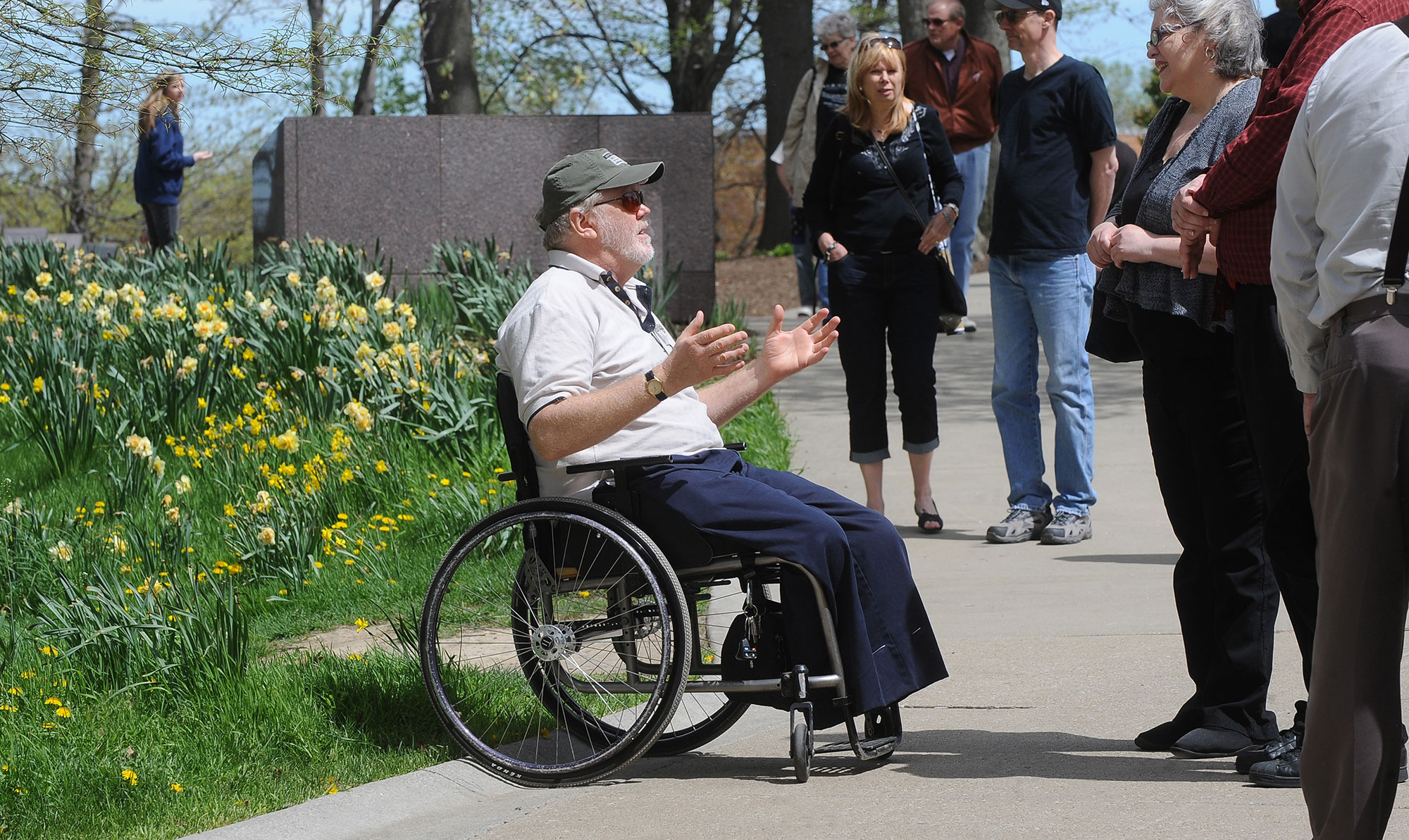From Remembrance to Renewal
May 4, 1970 the Kent State Shootings
The 67 shots that rang out at Kent State amid a May 4, 1970 Vietnam War protest, killing four students and wounding nine, reverberate nearly 50 years later. Many historians see the shootings as the moment America turned, finally and forcefully, against the war.
The actions of the Ohio National Guard made Kent State the custodian of painful history. With the passage of time, however, the university asks itself: what might the wound of May 4 help us to accomplish?
Kent State's previous president, Beverly J. Warren said, “The task we have set for ourselves is to not only remember, but reflect and renew. We must lift our collective voices to effect positive change.”
Voices of Remembrance and Renewal

Dean Kahler
Dean Kahler was one of nine students shot and wounded on May 4 – paralyzed for life by a spinal injury. As a 19-year-old freshman, he adapted to a wheelchair, returned to Kent State to finish his degree and pursued a career of public service. He secured access for disabled people to public facilities across Ohio.
“With a little bit of work, you, too, can do something about the political environment,” says Mr. Kahler. He remains a community volunteer in his hometown of East Canton, Ohio.
“Ohio” by Crosby, Stills, Nash & Young
Neil Young wrote the lyrics to “Ohio” after seeing Life magazine photo coverage of the Kent State shootings. Crosby, Stills, Nash & Young recorded it on May 21, 1970, less than three weeks after the shootings. “Ohio” was rush-released and got immediate, heavy radio play, especially on FM “underground” stations.
Tin soldiers and Nixon’s coming
We’re finally on our own.
This summer I heard the drumming
Four dead in Ohio.
“Ohio” became a counterculture anthem and has stood the test of time. The song was inducted into the Grammy Hall of Fame in 2009.


Laura Davis
Laura Davis was a Kent State freshman in May 1970. In later life, she became a catalyst for remembrance and renewal. Ms. Davis was a professor of English at Kent State and became the founding director of the May 4 Visitors Center. With Kent State community members Carol Barbato, Mark Seaman and Jerry Lewis, Ms. Davis worked tirelessly to ensure that the shooting site was designated a National Historic Landmark, which occurred in 2016.
Alan Canfora
Alan Canfora was shot in the wrist May 4. He recovered to become a lifelong “student organizer and political activist.” He is impressed by today’s young people who advocate change: “They urge people to vote! My generation, we didn’t do that.” Mr. Canfora is also heartened by Kent State’s determination to remember, reflect and seek renewal: “The university Is embracing its duty at long last.”


Tom Grace - Photo Courtesy of Christian Bobak, Photographer
TOM GRACE
As a Kent State student, Tom Grace felt a personal stake in the May 1970 antiwar protests: his girlfriend’s brother had been killed in Vietnam just a week earlier. When the Guard opened fire, Mr. Grace’s foot was shattered. Today, he says, his anger has subsided, “but it fueled a lot of political involvement over the years.” He became a historian. “You cannot be a person involved in social change and not be optimistic.”
Image

traveling stanzas at chautauqua

Capture your own creative response to this and other Chautauqua presentations with a visit to the Traveling Stanzas exhibit space in the Colonnade Building at Bestor Plaza.
Write poetry on Chautauqua weekly themes and share it digitally, through videos or on postcards printed on the spot.
Traveling Stanzas is a project of Kent State’s Wick Poetry Center, directed by David Hassler, in partnership with the Chautauqua Institution. Get more details at the Chautauqua Makerspace website.
Beverly J. Warren Previous President, Kent State University
Image


Beverly J. Warren became the 12th president of Kent State in July 2014. While leading the institution toward the 50th anniversary of the May 4 shootings, President Warren dedicated herself to creating a university culture where students discover their passion and purpose in life.
Warren is a renowned scholar in the fields of education and exercise physiology. Prior to leading Kent State, she earned two doctorates – an Ed.D. in administration of higher education from the University of Alabama, and a Ph.D. in exercise physiology from Auburn University – and served as provost and senior vice president of Virginia Commonwealth University. She is a North Carolina native.

may 4 Visitors Center
Relive the political and cultural upheaval of the 1960s, as well as the pivotal events of May 4, 1970, at the May 4 Visitors Center on the Kent State campus.
Artifacts and multimedia tell the story of the day Kent State was thrust into a global spotlight. The nearby May 4 Memorial plaza bids visitors to “Inquire, Learn, Reflect.”
Kent State is committed to honoring those lost or wounded on May 4, 1970. 50th anniversary events begin in fall 2019 and continue through May 4, 2020. To receive commemoration updates, go to the May 4, 2020 Commemoration website.
The May 4 Visitors Center is at 101 Taylor Hall, near the historic shooting site. Admission is free. Plan your visit at the May 4th Visitors Center.
kent state University

Discover one of America’s finest and largest public university systems. Founded as a teacher-training school in 1910, Kent State today serves nearly 40,000 students across eight campuses in Northeast Ohio, and is an engine for regional, economic, cultural and workforce development. U.S. News & World Report ranks Kent State in the first tier of Best National Universities.
For more, visit Kent State University.

